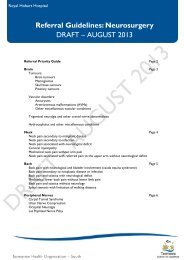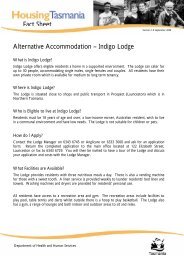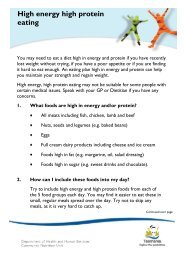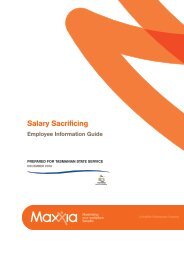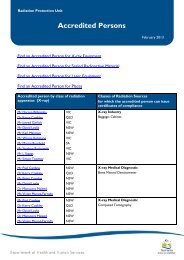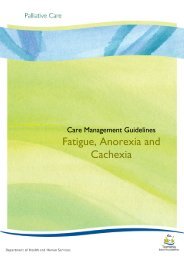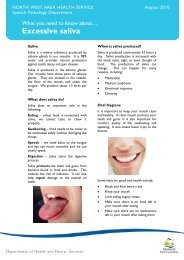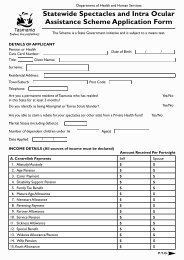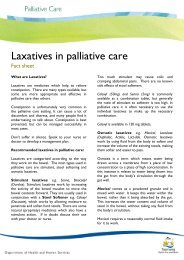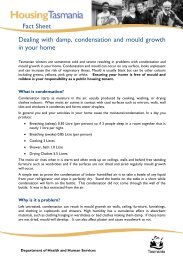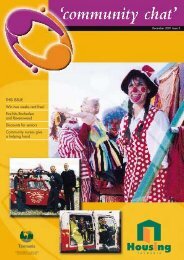Breast Self Examination.pub (Read-Only)
Breast Self Examination.pub (Read-Only)
Breast Self Examination.pub (Read-Only)
You also want an ePaper? Increase the reach of your titles
YUMPU automatically turns print PDFs into web optimized ePapers that Google loves.
BREAST SELF EXAMINATION<br />
(BSE)<br />
Regular breast self examination (BSE) is<br />
important for the early detection and<br />
treatment of breast cancer. It can help you to<br />
become familiar with your breasts and to<br />
identify any changes that might need to be<br />
checked.<br />
When should I do BSE?<br />
Once you are 40 years old, do BSE every<br />
month. If you still have periods, do BSE three<br />
to four days after your period ends.<br />
Otherwise choose a particular day of the<br />
month.<br />
Getting ready to check your right breast<br />
• lie on your left side with your knees bent;<br />
• now lean back so that your shoulders are<br />
flat, twisting at the waist (don’t move your<br />
legs);<br />
• put your right hand behind you head; and<br />
• use your left hand to check your right<br />
breast.<br />
How to check each spot<br />
• use the flat part of your fingers;<br />
• move your fingers slowly in circles at each<br />
spot;<br />
• at each spot, feel first with light pressure,<br />
then with firm pressure; and<br />
• feel for a lump or thickening.<br />
Check up and down in strips<br />
• check your breast up and down in strips,<br />
beginning in your armpit;<br />
• first, move your hand slowly down your<br />
breast;<br />
• at the bottom of your breast, move your<br />
fingers across and start a new strip up your<br />
breast;<br />
• continue moving your hand in strips, up<br />
and down your breast;<br />
• when you reach your nipple, lie flat by<br />
twisting at the waist and straightening<br />
your legs;<br />
• examine the rest of your breast in strips;<br />
and<br />
• Bring your left arm down by your side and<br />
feel in your arm pit for lumps.<br />
Checking your left breast<br />
• lie on the right hand side with your knees<br />
bent;<br />
• roll back by twisting at the waist so your<br />
shoulders are flat;<br />
• put your left arm behind your head; and<br />
• use your right hand to examine your left<br />
breast in the same way as for the right<br />
breast.<br />
If you have a small breasts you can do BSE<br />
standing in the shower using the same<br />
method.<br />
Carry out a mirror check<br />
Undress and stand in front of a mirror.<br />
Raise your arms above your head and look for:<br />
• any changes in the size and shape of your<br />
breasts;<br />
• any dimpling in the skin;<br />
• any discharge from one of the nipples; and<br />
• any change in your nipple such as a turned in<br />
nipple.<br />
If you find a lump or thickening while<br />
examining your breast, see a doctor.<br />
Other breast checks<br />
Once you are 40, it’s a good idea to have your<br />
breasts examined by your doctor.<br />
If you are over 50, <strong>Breast</strong> Screening Tasmania<br />
recommends you have a mammogram every<br />
two years.<br />
Sexual Health Service Tasmania is staffed<br />
Monday to Friday from 8.30 am until 5.00 pm.<br />
Clinic times vary from site to site so please<br />
contact your local office for details (see contact<br />
details on the back of this pamphlet).
Sexual Health Service<br />
Clinical Services<br />
HOBART<br />
60 Collins Street<br />
Hobart 7000<br />
Ph: (03) 6233 3557<br />
LAUNCESTON<br />
42 Canning Street<br />
Launceston 7250<br />
Ph: (03) 6336 2216<br />
DEVONPORT<br />
23 Steele Street<br />
Devonport 7310<br />
Ph: (03) 6421 7759<br />
BURNIE<br />
11 Jones Street<br />
BURNIE 7320<br />
Ph: (03) 6434 6315<br />
SEXUAL HEALTH SERVICE<br />
A joint Australian and State<br />
Government Program<br />
The Royal Hobart Hospital is Tasmania’s<br />
largest hospital and provides a number of<br />
state-wide services including cardiothoracic<br />
surgery, neurosurgery, burns management,<br />
hyperbaric and diving medicine, neonatal<br />
intensive care and high-risk obstetrics. It is<br />
the major teaching and research hospital for<br />
the State and works closely with the<br />
University of Tasmania.<br />
Many students in the health care professions<br />
are taught within the Hospital, and gaining<br />
skills in examining and interviewing patients<br />
is an important part of their education and<br />
training. We ask for your co-operation and<br />
encourage you to participate in our teaching<br />
and research activities. Your permission is<br />
required for participation.<br />
The Royal Hobart Hospital encourages<br />
feedback from patients, relatives and<br />
visitors. This feedback helps staff to better<br />
understand the needs of patients and provide<br />
the best possible patient care.<br />
The Royal Hobart Hospital<br />
is a smoke-free site<br />
Date: Feb 07 Review Date: Feb 08<br />
Information<br />
Pamphlet<br />
<strong>Breast</strong> <strong>Self</strong><br />
<strong>Examination</strong>



